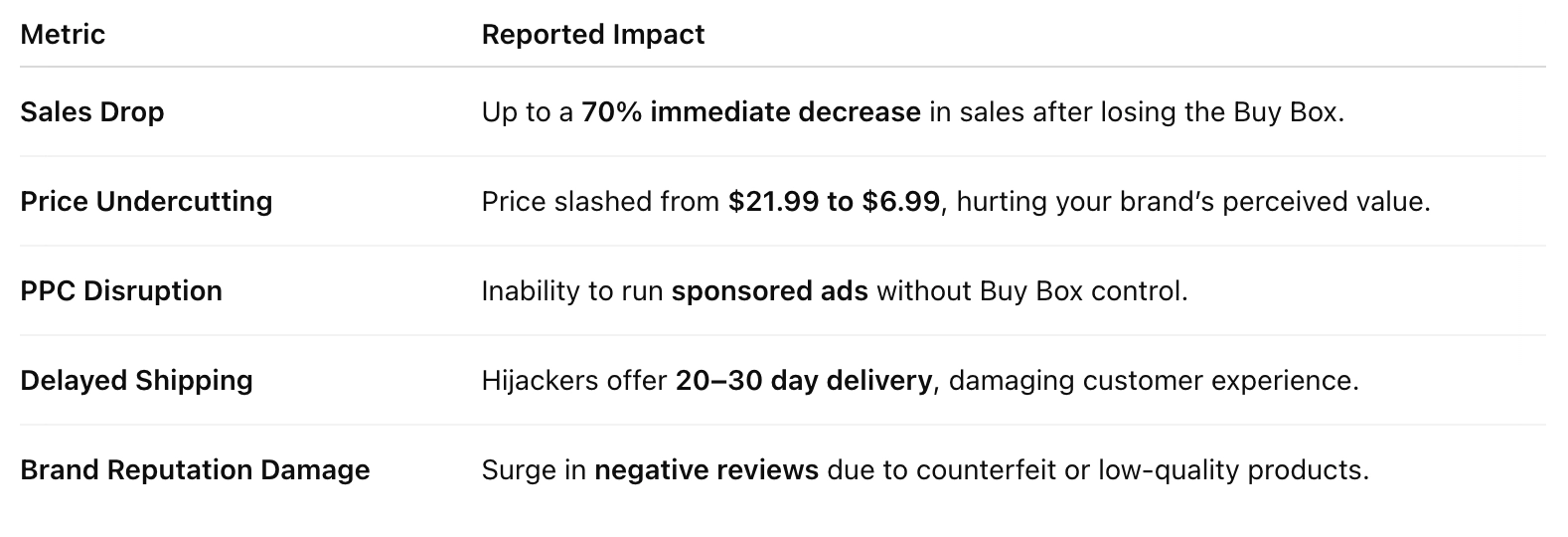
Hijackers on your Amazon listing can disrupt your business, violate your MAP price, and harm your brand’s reputation. Acting hastily can escalate conflicts or lead to compliance issues. At Brand Alignment, we offer tailored strategies to remove hijackers, backed by thorough investigation and professional enforcement techniques.
Table of Contents
What is an Amazon Hijacker?
An Amazon hijacker is an unauthorized third-party seller who takes over your product listing. They often sell counterfeit products or list lower-quality versions of your item at a reduced price, causing:
- Lost revenue and market share.
- Undercut your MAP price to gain the Buy Box.
- Negative customer reviews about your products.
- Damage to your brand’s integrity and customer trust.
Are Hijackers and Unauthorized Sellers the Same?
Not exactly. While all hijackers are unauthorized sellers, not all unauthorized sellers are hijackers.
Amazon Hijackers
- Take over your existing listing (usually on products with an active Buy Box and weak brand protection).
- Use your ASIN, your images, and sometimes even your copy.
- Sell a product that looks like yours — whether it’s authentic, diverted, or counterfeit.
- Main threat: They steal the Buy Box and confuse your customers.
Hijackers are a subtype of unauthorized sellers.
Amazon Unauthorized Sellers
- Any seller not officially authorized by your brand to sell your products.
- They might create their own listings or join your existing one (like hijackers).
- They may sell:
- Genuine products sourced through unauthorized (gray market) channels.
- Stolen, expired, used, or counterfeit items.
Not all unauthorized sellers hijack listings, but all unauthorized sellers weaken your brand control and pricing integrity.
Why Do Amazon Hijackers Target Listings?
Amazon hijackers typically target:
- High-performing listings with strong sales and reviews.
- Private label products lacking proper intellectual property protection.
- Listings with inconsistent or absent monitoring.
How to Remove an Amazon Hijacker
1. Identify the Hijacker
Use Amazon Seller Central to monitor your product listings. Signs of hijacking include:
- A new seller offering your product at a suspiciously low price.
- Negative reviews complaining about counterfeit goods or quality issues.
- Unusual changes in your Buy Box percentage loosing revenue.
2. Verify Unauthorized Activity
Conduct a test buy to confirm if the hijacker is selling counterfeit goods. Check for:
- Packaging differences.
- Inferior product quality.
- Lack of consistency with your branding.
3. Send a Cease and Desist Letter
Notify the hijacker of their violation by sending a Cease and Desist Letter. Include:
- Evidence of your intellectual property rights.
- Proof of their unauthorized activity.
- A clear demand for compliance and removal.
4. File a Complaint with Amazon
If the hijacker does not comply, use Amazon’s Report a Violation Tool. Provide:
- Documentation from your test purchase.
- Trademark or copyright registration details.
- Screenshots of the hijacker’s listing.
5. Escalate to Legal Action if Necessary
Persistent hijackers may require legal intervention. Consult with an intellectual property lawyer to issue a formal legal notice or take further action.
The Risks of Acting Without a Plan
Removing a hijacker requires precision. Mistakes like lowering your price or delisting your product can:
- Violate Amazon’s policies.
- Strengthen the hijacker’s position.
- Cause unnecessary losses.
It is critical to investigate thoroughly before taking action.
Proactive Strategies to Prevent Amazon Hijackers
1. Register with Amazon Brand Registry
Enroll in Amazon Brand Registry to access tools that help prevent hijackers, such as:
- Automated alerts for suspicious activity.
- Advanced monitoring of your listings.
2. Monitor Listings Regularly
Use a MAP monitoring software to track price changes and unauthorized sellers in real time.

3. Strengthen Your Intellectual Property Protection
Secure trademarks and copyrights for your brand and products to make enforcement easier.
4. Educate Your Customers
Include a note in your product descriptions, warning customers to buy only from authorized sellers to avoid counterfeit goods.
Why Immediate Action Matters

*Impact of Hijackers on Buy Box Loss and Sales

Brand Alignment’s Process for Removing Hijackers
Step 1: Monitor and Detect
We use advanced technics to identify:
- Unauthorized sellers and MAP price violations.
- Suspicious activity on your listings.
- Sellers competing for the Buy Box.
Step 2: Verify with Test Buys
We conduct test buys to confirm:
- Counterfeit products or unauthorized sellers.
- This evidence required for enforcement actions.
Step 3: Seller Investigation
Our team uncovers critical details (seller investigation experts):
- Seller identities and inventory sources.
- Patterns of violations affecting your brand.
Step 4: Take Strategic Action
We address violations with:
- Professionally crafted cease-and-desist letters.
- Gradual escalation for non-compliant sellers.
- Supply chain tracing to prevent future issues.
Step 5: Maintain Compliance
Why MAP Price Protection Matters
MAP price violations create instability. They:
- Force authorized sellers to lower prices.
- Erode customer trust in your brand.
- Reduce your overall earnings.
Brand Alignment ensures MAP price compliance, preserving your brand’s value across marketplaces.
Why Choose Brand Alignment?
Don’t let an Amazon hijacker harm your brand. Take action today with proven strategies and expert guidance.
- Advanced monitoring tools.
- Proven enforcement strategies.
- Professional investigations to protect your listings.
Take Control of Your Amazon Listings





